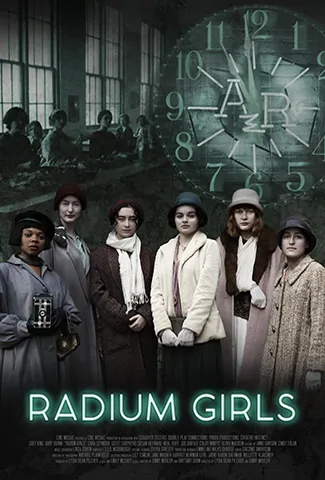| It’s easy to get stuck in a cinematic crossroads when looking at Radium Girl by Lydia Dean Pilcher & Ginny MOHLER. The film is a real story with a wonderful cast (including Joey King from “The Act”), and it’s inspired by an up-and-coming actress. When you look closely at the final product, it’s clear that there is something more uneven underneath the layers of vintage aesthetics and electro-swing mixes. This kind of sloppy filmmaking is more frustrating than the unfair cards that our heroines are dealt. It’s important that you understand the background of the story before watching the film. In 1917, United States Radium Corporation had three factories, including one in Orange (New Jersey). The factories hired hundreds young women to paint watch dials in order to finish their product faster. The women’s lives began to change when they were instructed to lick the brushes. Radium’s supposed “magical properties” were not true. These girls showed its true toxic effects, from their jaws to their glowing skin. In an attempt to seek revenge, the girls from these factories would go to court and fight against the Radium Corp., but the true conclusion of the story wouldn’t come until the mid-1970s. Even so, many questions remain unanswered. The story revolves around two New Jersey sisters (Bessie King and Josephine Cavallo, ” landline“) who work as watch dial painters for (the newly retitled) American Radium. Josephine falls ill while Bessie dreams of becoming a Hollywood starlet. The pair must now discover the truth about the glowing liquid which funds their lives. As more secrets are revealed, Bessie’s Hollywood dreams change to justice. She risks everything to protect the lives of not only her family and close friends, but also the many workers around the world who put themselves at risk. Bessie, the other girls and their corporate enemies are not going to give up without a fight. The story of Radium Girls, both on-screen and off-screen, is a classic David vs. Goliath scenario. In this case, however, it seems that the emphasis is on making the story accessible to a younger audience rather than paying homage to the individuals involved. If you are the type of person who gets drawn into Ryan Murphy miniseries because they have a lot more glitz than grit, then you will know (or not) what this movie is about. Mohler’s and Brittany Shaw’s screenplay has a lot of dialogue that sounds more like it was written for Tumblr rather than an authentic movie. The screenplay is a wish-fulfillment, but it’s not organic. This choice is most evident when Mohler or Shaw put Bessie in social situations. The approachable nature is borderline hilarious. From hipster-like conversations at parties to melodramatic calls for justice in the most embarrassing of situations, these interactions are borderline funny. Bessie’s mentions of the latest films and her fangirlish comments make every line seem too polished. There is nothing wrong with portraying these events to a modern audience in a more appealing manner, but one wonders how much better it would have been if the story had been in more polished hands. Joey King (Wish upon) is a great addition to the film. She was already able to shine in 2018, when the film went through its first festival circuit. As we know (as well as Hulu and Netflix), she did. King’s puppy dog eyes, and her memorable pout, draw the viewer to her no matter where in the frame she is. Winona fans from the 90s will recognize her raw magic. She is as beautiful as she’s heartbreaking and just as enchanting as she’s relatable. She delivers every line of dialogue, no matter how cheesy it may be. The rest of cast also does a good job of making the most of their roles. Abby Quinn (” Submission“) and Susan Heyward ( ” Poltergeist“) leave lasting impressions. They each bring their own brand of appeal and vulnerabilities to their roles. Greg Hildreth, who played Henry Barry as the girl’s lawyer in “Wall Street Money Never Sleeps“, is perhaps the biggest surprise. Hildreth is an actor who hasn’t been given nearly enough opportunities to work in film. He has a Jimmy Stewart-like quality, which (despite not getting as much screentime as he deserves) leaves a charm. The work of set designer Heather Yancey and costume designer Sylvia Grieser has a similar charm. Some may argue that the visuals are more sleek and modern than in other period dramas. However, Grieser and Yancey have a ModCloth-like whimsy to their work. It’s hard to not drool at every garment, furniture piece, and other detail. Though some viewers may find the style-over-accuracy approach to be jarring for them, Grieser & Yancey have done a great job in giving the heroines of the film their own unique aesthetic, which is as brave as their actions. Radium Girls, in the end, is a trail mix of independent biopic dramas. The film has a sweetness that is hard to deny, but also a saltiness that is uneven. The 102-minute film is a mixture of flavors that don’t complement each other. This adaptation is easy to digest, but the elements that blend well stand out. Although Pilcher and Mohler’s final product does not take the same risk as its titular heroines’, this may lead them to bolder choices and greater confidence as their careers advance. Their work can glow without using a single drop of radium. | |

Radium Girls (2018)
Genre(s): Drama
MPAA Rating:NR
Director(s): Ginny Mohler, Lydia Dean Pilcher
Actor(s): Abby Quinn, Cara Seymour, Colby Minifie, Collin Kelly-Sordelet, Greg Hildreth, Joey King, Neal Huff, Scott Shepherd, Susan Heyward
Writer(s): Brittany Shaw, Ginny Mohler
Producer(s): Lydia Dean Pilcher, Emily McEvoy
Studio(s): Cine Mosaic, Juno Films
Length:102 minutes
Release Date(s):US: October 30, 2020




